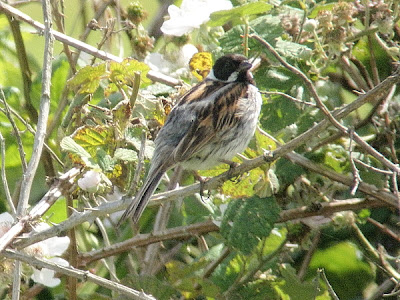All day on Nerut Dagi, starting off around Pension Cesme before breakfast, to avoid the sun-rise tourist rush, then most of the rest of the morning around the summit after better views of Kurdish Red-tailed Wheatears. We then worked our way slowly down back to the Pension and finished the day in the orchards below it. Birds seen included 3 Alpine Swifts, 10 Shore larks, Tawny Pipit, 12(!!) White-throated Robins, 3 Red-tailed, 2 Finsch's and 5 Black-eared Wheatears, 4 Rock Thrushes, 6 Orphean and 4 Upcher's Warblers, 5 Pale Rock Sparrows, 12 Snowfinches, 2 Crimson-winged Finches and 10 Cinereous Buntings.
 |
| Nemrut Dagi summit from above Pension Cesme |
 |
| view from Nemrut Dagi east towards the Ataturk Baraji |
 |
| view SE from Nemrut Dagi |
 |
| the traditional view of the eastern terrace and the summit |
 |
| stone heads on the western terrace |
 |
| stone heads on the eastern terrace |
 |
| more heads on the western terrace |
 |
| the western terrace with Nick just about visible on the left |
 |
| Red-tailed Wheatear at the summit |
 |
| showing red tail |
 |
| Red-tailed Wheatear half way back to Pension Cesme |
 |
| showing the white in the outer tail feathers |
 |
| a very smart wheatear indeed |
 |
| flighty Snowfinch near the summit |
 |
| young Snowfinch |
 |
| Shore Lark at Nemrut Dagi |
 |
| nest of Shore Lark |
 |
| Rock Thrush or bowerbird? |
 |
| Pale Rock Sparrow at Nemrut Dagi |
 |
| and a very distinctive buzzy song too although it wasn't always easy to tell where it was coming from |
 |
| Cinereous Bunting at Nemrut Dagi |
 |
| they were common immediately above Pension Cesme |
 |
| male Black-headed Bunting at Nemrut Dagi |
 |
| female Black-headed Bunting at Nemrut Dagi |
 |
| Black-eared Wheatear at Nemrut Dagi |
 |
| White-throated Robin at Nemrut Dagi |
 |
| a somewhat dishevelled individual |














































































